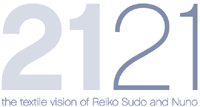
|
education
programme : AMBIGUOUS SPACES : Five questions emerged from these breakout groups: 'Do we need a forum that everyone can access and interact with, that provides information on these new smart materials?’ Is any time when textiles don't carry meaning?" Do we need to understand the heritage of textiles? Is textile a language that crosses cultures? Should we be the architects of craft and new technology? Report from the breakout group led by Sally Freshwater Initially the group seemed to show concern for the longevity of fabrics that are used in architecture and to explore the idea of how obviously fabrics have been used in relation to buildings (the Selfridges building (in Manchester?) was mentioned when it was wrapped up). The conversation quickly turned to enquiring about what sort of materials are being used, which revealed that there is a lack of knowledge about these new smart materials and how they are used within architecture. It was pointed out that everyone in the group was from a textile background and very few had made contact or indeed worked with designers in any other discipline or aspect at all. Those in education revealed that there are libraries available to students that document these materials, but outside education there seemed little access to them as advertising and availability is largely directed towards designers and commercial/public uses. However further information emerged (from Frances Geeson) that there are biannual trade fairs held in Frankfurt (Avantex and Text Textile) showing and selling all forms of smart fabrics for architects, medics, electronics and governments. These geo/nano/techno textiles are smart in different ways. This brought us back to education whereby, the thought was that cross discipline should be encouraged to support interdependency between textiles and architecture as well as a general cross fertilization of ideas and techniques between all disciplines (Ceramics, glass, metal etc). It was also decided that National and International collaborative work should be encouraged in our education systems and in the wider artist/designer maker society. The resulting concern that emerged was that there is no forum where this knowledge can be accessed by artists. Report from the breakout group led by Frances Lord 1)The function of textiles: to delight in both the making and the finished product 2) Cloth and culture Discussion around technological/digital developments and the thought that , given Reiko Sudo's quote that we weave the culture of our times, the potential for building emotion into the design and construction of fabric 'was a sign of the times' Discussion around specific cultural clothing (full length Islamic dress was the particular illustration, though it may be delicate to mention), that our response to these was affected by our own particular culture and the need to delve more and seek understanding. Clothing as a means of creating personal space 3)Architecture Reference to the Nottingham Arts building, involving traditional lace makers and their work in the design of the building features. The rigidity of architecture , the fluidity of textiles and its potential to differentiate space Who should designers be talking to: 4) Textiles and Narrative Memory and meaning - a theme that had been running throughout the day. The comment " Report from the breakout group led by Maxine
Bristow The sensorial embrace of visceral meaning The semiotic signals of status and meaning The space between skin and clothing Creating a comfortable whispering layer The hidden language of making |
Break out group No 4. Reporter: Dr Andie Robertson. Senior Lecturer BA (HONS) Textiles & Surface Design. BCUC What does craft mean? Traditionally considered to be a domestic pastime. In reference to a domestic and public space. Viewed as being practiced by past women artists, however less stigmatised work now. Earlier generations fighting to show ideas. RE: Catherine Bertola Is such work now more acceptable? Are we rediscovering notions of what it is to be women through making? Does freedom and choice liberate us to be more involved in the art of making? Is making no longer considered a chore but a choice on the part of women? Has globalisation meant that the handcrafted article is no longer
valued? Assimilation of craft traditions into new technologies: responses to textiles. Textiles as non-functional items. Architecture and textiles. Digital tracking. Is this in contrast to today’s poeticism of making? Is it time for textile designers to be leading the new textile technologies? It is time for a critical rearrangement of textiles, and a discussion surrounding new textiles development. Scope for use to offer knowledge to the technical realm, it is evident that these new technologies and industries require our material expertise. The bringing together of skills and technology further highlights the interdisciplinary nature of new textile developments. The range of disciplines has meant that textiles skills are being subsumed into engineering areas. These shouldn’t be buried. Articulations/ discussions around craft may help use to retrieve the lost ground as regards designing and making technologies. There is a clear juxtaposition of the hand made as opposed to the digital. Is it tragic to lose our hand craft skills? What exactly do we mean when referring to the tragedy in losing handcraft? Hand making is fundamental to humans. It is the most fundamental method of construction. This is not about being nostalgic for past practices. It is liberating, it is about our own making experiences. There is still time for a co-existence between hand and electronic media. Digital technologies are making and designing tools, however they won’t supplant our skills. We have to be aware of technology trends. The stitch or thread has the power to heal; moreover, it is therapeutic and has a connection to the maker. It is accessible and communicates with others. It has a directness made more resonant by working into the hands. To the heart via the hands and the head. Digital technology is still new, however we are not yet sure how
to use it to communicate our thoughts or ideas or make connections
to the past. |


